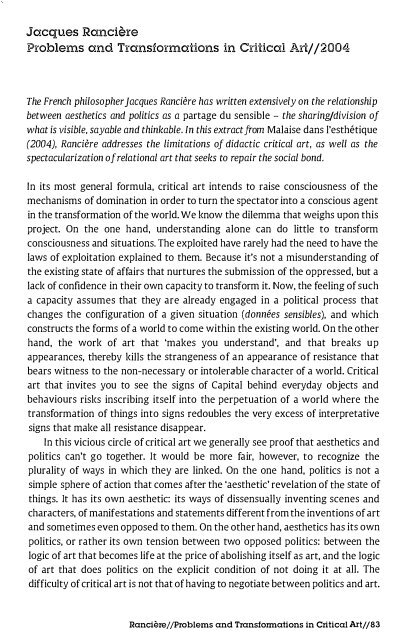Create successful ePaper yourself
Turn your PDF publications into a flip-book with our unique Google optimized e-Paper software.
Jacques Ranciere<br />
Problems and Transformations in Critical Art; /2()04<br />
The French philosopher Jacques Ranciere has written extensively on the relationship<br />
between aesthetics and politics as a partage du sensible - the sharing/division of<br />
what is visible, sayable and thinkable. In this extract from Malaise dans l'esthetique<br />
(2004), Ranciere addresses the limitations of didactic critical art, as well as the<br />
spectacularization of relational art that seeks to repair the social bond.<br />
In its most general formula, critical art intends to raise consciousness of the<br />
mechanisms of domination in order to turn the spectator into a conscious agent<br />
in the transformation of the world. We know the dilemma that weighs upon this<br />
project. On the one hand, understanding alone can do little to transform<br />
consciousness and situations. The exploited have rarely had the need to have the<br />
laws of exploitation explained to them. Because it's not a misunderstanding of<br />
the existing state of affairs that nurtures the submission of the oppressed, but a<br />
lack of confidence in their own capacity to transform it. Now, the feeling of such<br />
a capacity assumes that they are already engaged in a political process that<br />
changes the configuration of a given situation (donnees sensibles), and which<br />
constructs the forms of a world to come within the existing world. On the other<br />
hand, the work of art that 'makes you understand', and that breaks up<br />
appearances, thereby kills the strangeness of an appearance of resistance that<br />
bears witness to the non-necessary or intolerable character of a world. Critical<br />
art that invites you to see the signs of Capital behind everyday objects and<br />
behaviours risks inscribing itself into the perpetuation of a world where the<br />
transformation of things into signs redoubles the very excess of interpretative<br />
signs that make all resistance disappear.<br />
In this vicious circle of critical art we generally see proof that aesthetics and<br />
politics can't go together. It would be more fair, however, to recognize the<br />
plurality of ways in which they are linked. On the one hand, politics is not a<br />
simple sphere of action that comes after the 'aesthetic' revelation of the state of<br />
things. It has its own aesthetic: its ways of dissensually inventing scenes and<br />
characters, of manifestations and statements different from the inventions of art<br />
and sometimes even opposed to them. On the other hand, aesthetics has its own<br />
politics, or rather its own tension between two opposed politics: between the<br />
logic of art that becomes life at the price of abolishing itself as art, and the logic<br />
of art that does politics on the explicit condition of not doing it at all. The<br />
difficulty of critical art is not that of having to negotiate between politics and art.<br />
Rancierej jProblems and Transformations in Critical Art/ /83








